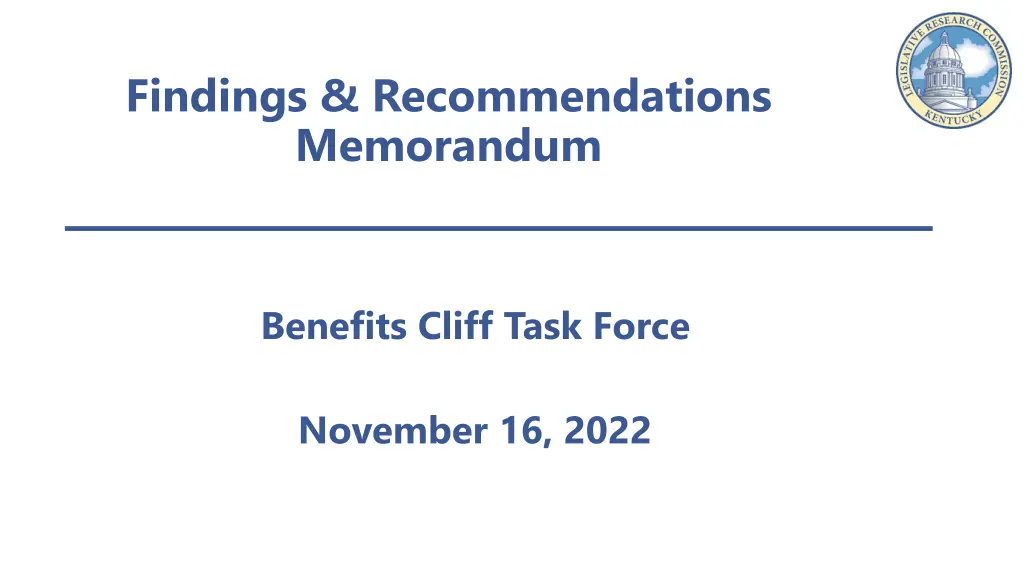
Understanding the Benefits Cliff Effect in Public Assistance Programs
Learn about the benefits cliff effect, its impact on public assistance beneficiaries, efforts to address it in Kentucky, and potential solutions such as tiering benefits. Discover key findings and recommendations for navigating this challenge effectively.
Download Presentation

Please find below an Image/Link to download the presentation.
The content on the website is provided AS IS for your information and personal use only. It may not be sold, licensed, or shared on other websites without obtaining consent from the author. If you encounter any issues during the download, it is possible that the publisher has removed the file from their server.
You are allowed to download the files provided on this website for personal or commercial use, subject to the condition that they are used lawfully. All files are the property of their respective owners.
The content on the website is provided AS IS for your information and personal use only. It may not be sold, licensed, or shared on other websites without obtaining consent from the author.
E N D
Presentation Transcript
Findings & Recommendations Memorandum Benefits Cliff Task Force November 16, 2022
Finding #1 The terms benefits cliff or the cliff effect refer to the sudden decrease in public benefits as the result of an increase in earnings. 2
Finding #2 For public assistance beneficiaries, the benefits cliff can serve as a barrier to gainful employment and self-sufficiency which in turn can increase the amount of time an individual or family remains on public assistance. 3
Finding #3 Kentucky is not alone in its attempts to better understand and address the benefits cliff. 4
Finding #4 The benefits cliff and continued access to affordable, quality child care are key concerns of Kentucky s business community as it creates significant staffing challenges. 5
Finding #5 The Cabinet for Health & Family Services (CHFS) is collaborating with the Kentucky Center for Statistics to make improvements to an existing benefits cliff calculator and to fully integrate the calculator into the online kynect portal by July 2024. CHFS is also working with the Education & Labor Cabinet to make an automatic job-match search engine available to public assistance recipients through the kynect portal. 6
Finding #6 Tiering public assistance benefits, or phasing out benefits as the recipient s income increases, as opposed to terminating benefits following a marginal increase in income offers an opportunity to smooth the benefits cliff. However, the ability of state to tier benefits and address the benefits cliff is significantly limited by federal regulations which govern most public assistance programs. 7
Finding #7 The Utah Department of Workforce Services serves as a model of efficiency and effectiveness in the delivery of employment and job training services. Unfortunately, federal law now prevents other states from integrating employment and job training services into a one-stop-shop agency like Utah s Department of Workforce Services. 8
Finding #8 CHFS has utilized pandemic-era federal funds to make improvements to the Child Care Assistance Program which could help to alleviate the child care benefits cliff faced by working families, but the federal funds used to finance these changes will run out in 2024. 9
Recommendation #1 Adopt a joint resolution directing CHFS to conduct a thorough review of all public assistance programs administered by the cabinet to identify all flexibilities permitted under federal law, including but not limited to the ability to tier benefits, which may afford the state the opportunity to address the benefits cliff in Kentucky without the need for federal action and requiring the cabinet to submit a report containing its findings and recommendations to the IJC on Health, Welfare, & Family Services no later than November 1, 2023. 10
Recommendation #2 Adopt a joint resolution directing CHFS, in cooperation with the Education & Labor Cabinet, to conduct a thorough audit of all employment and job training programs to identify service duplications, inefficiencies in service delivery, and opportunities for improvement including the possible integration of all employment and job training programs under a single administrative unit in state government and requiring the cabinets to submit a report containing their findings, recommendations, and an action plan to the IJC on Health, Welfare, & Family Services and the IJC on Economic Development & Workforce Investment no later than November 1, 2023. 11
Recommendation #3 Adopt a joint resolution directing CHFS to study the cost of maintaining pandemic-era changes to the Child Care Assistance Program once federal pandemic relief funds are exhausted and requiring the cabinet to report its findings to the IJC on Health, Welfare, & Family Services and the Budget Review Subcommittee on Human Resources no later than November 1, 2023. 12
Recommendation #4 Adopt a concurrent resolution urging the United States Congress to study the benefits cliff phenomenon and how current federal regulations limit the ability of states to effectively address the challenges created by the benefits cliff and to amend federal statutes and regulations to grant states the flexibilities necessary to mitigate or eliminate the benefits cliff including but not limited to amending funding and organizational provisions in the Workforce Investment & Opportunity Act that may prevent states from administratively integrating all federally funded employment and job training programs under a single administrative unit in state government. 13
Recommendation #5 Enact legislation requiring CHFS to integrate a user-friendly benefits cliff calculator tool that allows users to weigh the pros and cons of upward mobility and benefit eligibility into the cabinet s outreach and support efforts. 14
Recommendation #6 Enact legislation directing CHFS and the Department of Revenue to establish outreach and tax filing support programs to increase the number of eligible individuals, particularly low- income earners, who file a federal tax return and claim the federal Earned Income Tax Credit. 15
Recommendation #7 Identify opportunities and enact legislation that leverage public-private partnerships by creating new partnership programs to help reduce the impacts of the benefits cliff in certain circumstances. 16






















